tow Citroen DS4 RHD 2013.5 1.G Owner's Guide
[x] Cancel search | Manufacturer: CITROEN, Model Year: 2013.5, Model line: DS4 RHD, Model: Citroen DS4 RHD 2013.5 1.GPages: 400, PDF Size: 31.86 MB
Page 152 of 400
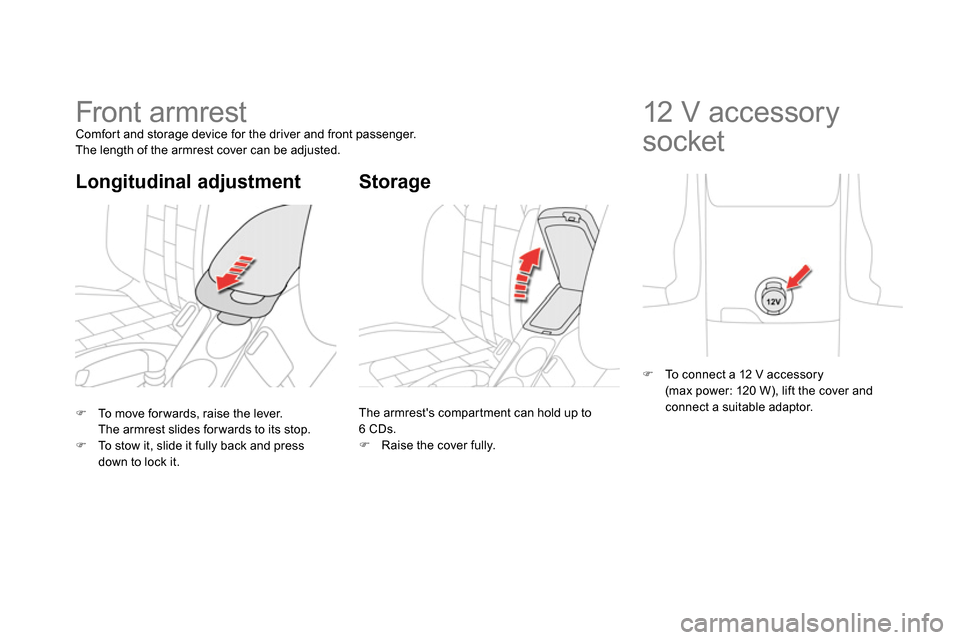
Longitudinal adjustment
Front armrest
Comfort and storage device for the driver and front passenger.
The length of the armrest cover can be adjusted.
The armrest's compartment can hold up to
6 CDs.
Raise the cover fully.
Storage
To move for wards, raise the lever.
The armrest slides for wards to its stop.
To stow it, slide it fully back and press
down to lock it.
12 V accessory
socket
To connect a 12 V accessory
(max power: 120 W), lift the cover and
connect a suitable adaptor.
Page 170 of 400
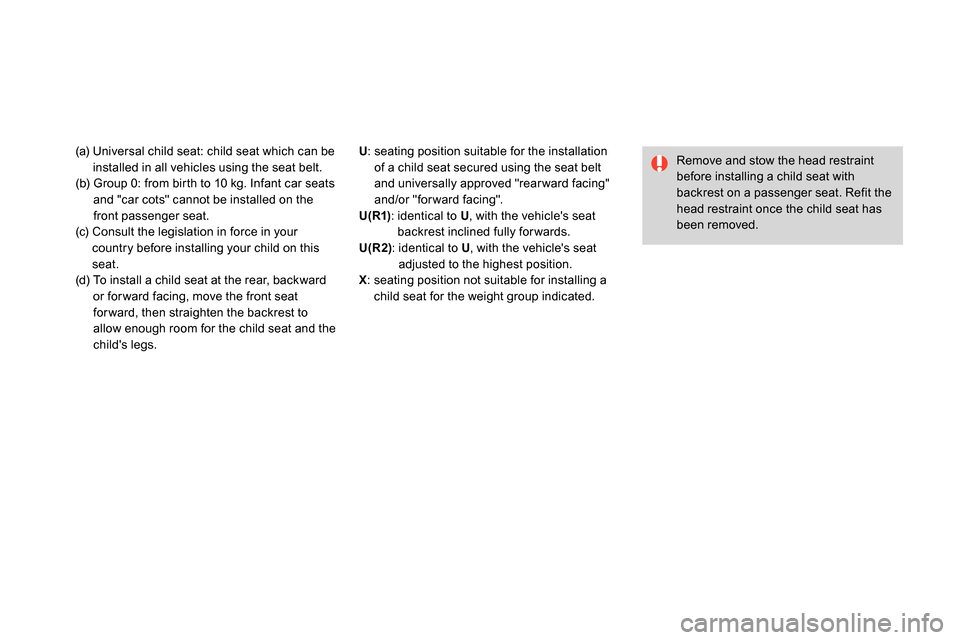
(a) Universal child seat: child seat which can be
installed in all vehicles using the seat belt.
(b) Group 0: from birth to 10 kg. Infant car seats
and "car cots" cannot be installed on the
front passenger seat.
(c) Consult the legislation in force in your
country before installing your child on this
seat.
(d) To install a child seat at the rear, backward
or for ward facing, move the front seat
for ward, then straighten the backrest to
allow enough room for the child seat and the
child's legs.
Remove and stow the head restraint
before installing a child seat with
backrest on a passenger seat. Refit the
head restraint once the child seat has
been removed.
U
: seating position suitable for the installation
of a child seat secured using the seat belt
and universally approved "rear ward facing"
and/or "forward facing".
U(R1)
: identical to U
, with the vehicle's seat
backrest inclined fully for wards.
U(R2)
: identical to U
, with the vehicle's seat
adjusted to the highest position.
X
: seating position not suitable for installing a
child seat for the weight group indicated.
Page 171 of 400
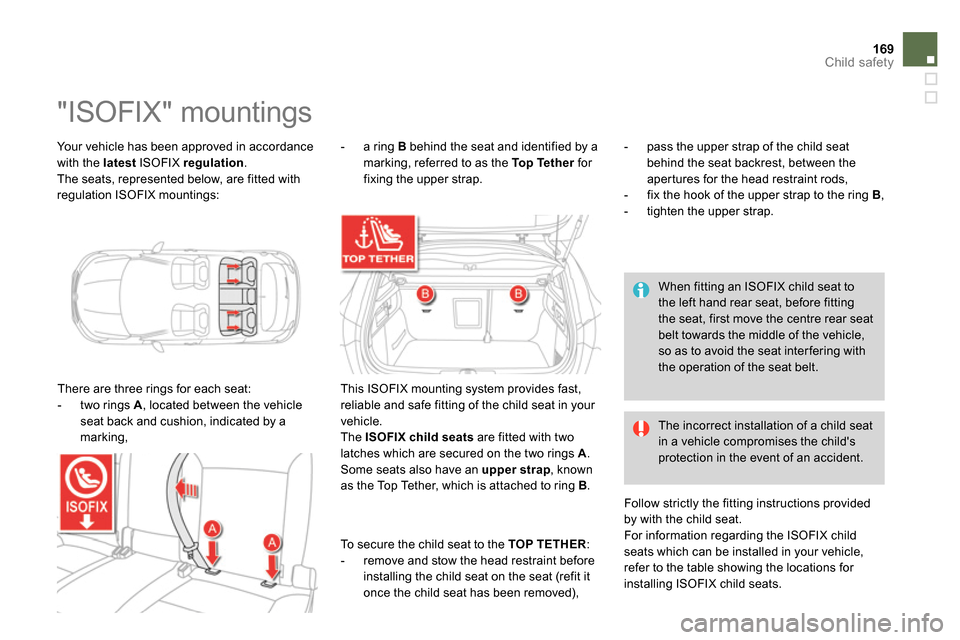
169Child safety
Your vehicle has been approved in accordance
with the latest
ISOFIX regulation
.
The seats, represented below, are fitted with
regulation ISOFIX mountings:
"ISOFIX" mountings
There are three rings for each seat:
- two rings A
, located between the vehicle
seat back and cushion, indicated by a
marking,
- a ring B
behind the seat and identified by a
marking, referred to as the To p Te t h e r
for
fixing the upper strap.
This ISOFIX mounting system provides fast,
reliable and safe fitting of the child seat in your
vehicle.
The ISOFIX child seats
are fitted with two
latches which are secured on the two rings A
.
Some seats also have an upper strap
, known
as the Top Tether, which is attached to ring B
. The incorrect installation of a child seat
in a vehicle compromises the child's
protection in the event of an accident.
Follow strictly the fitting instructions provided
by with the child seat.
For information regarding the ISOFIX child
seats which can be installed in your vehicle,
refer to the table showing the locations for
installing ISOFIX child seats. When fitting an ISOFIX child seat to
the left hand rear seat, before fitting
the seat, first move the centre rear seat
belt towards the middle of the vehicle,
so as to avoid the seat inter fering with
the operation of the seat belt.
- pass the upper strap of the child seat
behind the seat backrest, between the
apertures for the head restraint rods,
- fix the hook of the upper strap to the ring B
,
- tighten the upper strap.
To secure the child seat to the TOP TETHER
:
- remove and stow the head restraint before
installing the child seat on the seat (refit it
once the child seat has been removed),
Page 173 of 400
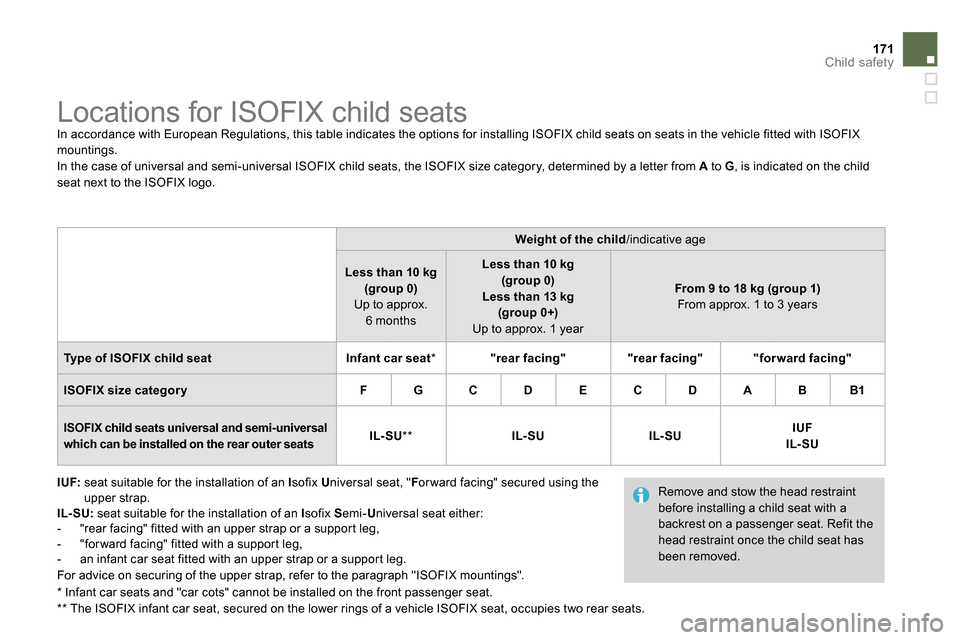
171Child safety
Locations for ISOFIX child seats
In accordance with European Regulations, this table indicates the options for installing ISOFIX child seats on seats in the vehicle fitted with ISOFIX
mountings.
In the case of universal and semi-universal ISOFIX child seats, the ISOFIX size category, determined by a letter from A
to G
, is indicated on the child
seat next to the ISOFIX logo.
IUF:
seat suitable for the installation of an I
sofix U
niversal seat, " F
or ward facing" secured using the
upper strap.
IL-SU:
seat suitable for the installation of an I
sofix S
emi- U
niversal seat either:
- "rear facing" fitted with an upper strap or a support leg,
- "for ward facing" fitted with a support leg,
- an infant car seat fitted with an upper strap or a support leg.
For advice on securing of the upper strap, refer to the paragraph "ISOFIX mountings".
* Infant car seats and "car cots" cannot be installed on the front passenger seat.
** The ISOFIX infant car seat, secured on the lower rings of a vehicle ISOFIX seat, occupies two rear seats.
Weight of the child
/indicative age
Less than 10 kg
(group 0)
Up to approx.
6 months
Less than 10 kg
(group 0)
Less than 13 kg
(group 0+)
Up to approx. 1 year
From 9 to 18 kg (group 1)
From approx. 1 to 3 years
Type of ISOFIX child seat
Infant car seat
*
"rear facing"
"rear facing"
"forward facing"
ISOFIX size category
F
G
C
D
E
C
D
A
B
B1
ISOFIX child seats universal and semi-universal
which can be installed on the rear outer seats
IL-SU
**
IL-SU
IL-SU
IUF
IL-SU
Remove and stow the head restraint
before installing a child seat with a
backrest on a passenger seat. Refit the
head restraint once the child seat has
been removed.
Page 178 of 400
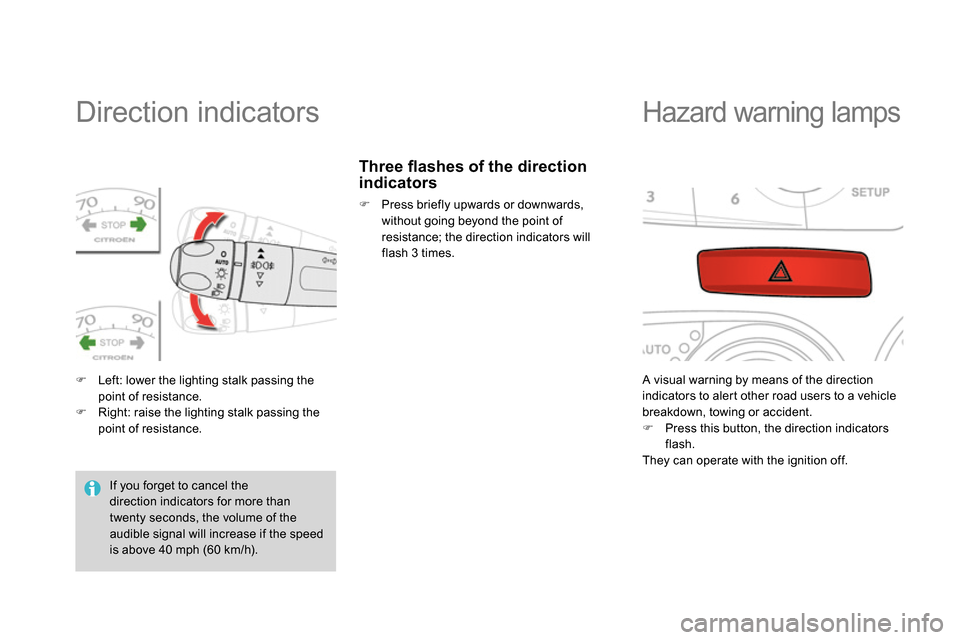
Direction indicators
Left: lower the lighting stalk passing the
point of resistance.
Right: raise the lighting stalk passing the
point of resistance.
Three fl ashes of the direction
indicators
Press briefly upwards or downwards,
without going beyond the point of
resistance; the direction indicators will
flash 3 times.
Hazard warning lamps
A visual warning by means of the direction
indicators to alert other road users to a vehicle
breakdown, towing or accident.
Press this button, the direction indicators
flash.
They can operate with the ignition off.
If you forget to cancel the
direction indicators for more than
twenty seconds, the volume of the
audible signal will increase if the speed
is above 40 mph (60 km/h).
Page 186 of 400
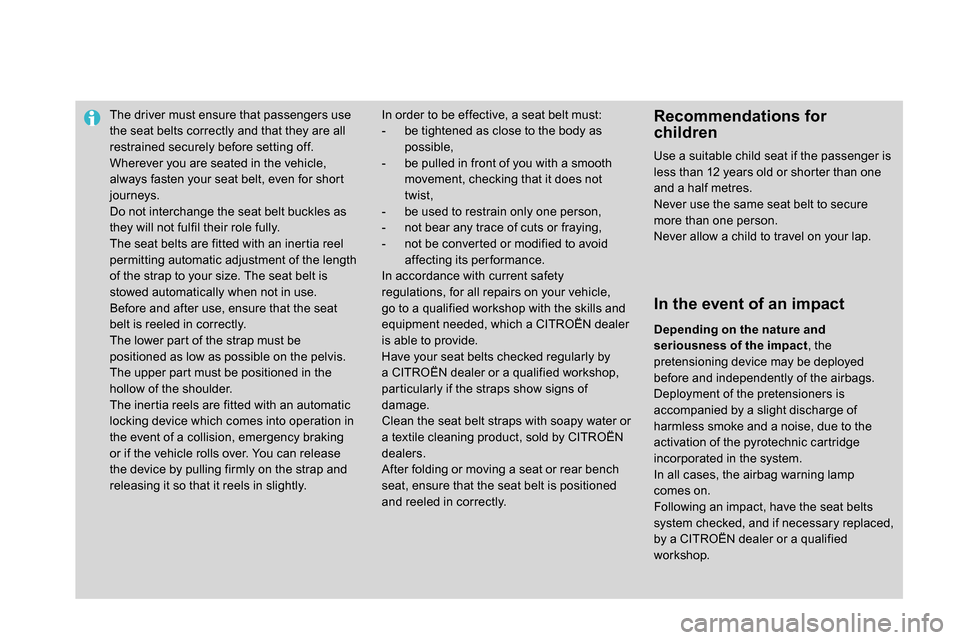
The driver must ensure that passengers use
the seat belts correctly and that they are all
restrained securely before setting off.
Wherever you are seated in the vehicle,
always fasten your seat belt, even for short
journeys.
Do not interchange the seat belt buckles as
they will not fulfil their role fully.
The seat belts are fitted with an inertia reel
permitting automatic adjustment of the length
of the strap to your size. The seat belt is
stowed automatically when not in use.
Before and after use, ensure that the seat
belt is reeled in correctly.
The lower part of the strap must be
positioned as low as possible on the pelvis.
The upper part must be positioned in the
hollow of the shoulder.
The inertia reels are fitted with an automatic
locking device which comes into operation in
the event of a collision, emergency braking
or if the vehicle rolls over. You can release
the device by pulling firmly on the strap and
releasing it so that it reels in slightly. In order to be effective, a seat belt must:
- be tightened as close to the body as
possible,
- be pulled in front of you with a smooth
movement, checking that it does not
twist,
- be used to restrain only one person,
- not bear any trace of cuts or fraying,
- not be converted or modified to avoid
affecting its per formance.
In accordance with current safety
regulations, for all repairs on your vehicle,
go to a qualified workshop with the skills and
equipment needed, which a CITROËN dealer
is able to provide.
Have your seat belts checked regularly by
a CITROËN dealer or a qualified workshop,
particularly if the straps show signs of
damage.
Clean the seat belt straps with soapy water or
a textile cleaning product, sold by CITROËN
dealers.
After folding or moving a seat or rear bench
seat, ensure that the seat belt is positioned
and reeled in correctly.
Recommendations for
children
Use a suitable child seat if the passenger is
less than 12 years old or shorter than one
and a half metres.
Never use the same seat belt to secure
more than one person.
Never allow a child to travel on your lap.
In the event of an impact
Depending on the nature and
seriousness of the impact
, the
pretensioning device may be deployed
before and independently of the airbags.
Deployment of the pretensioners is
accompanied by a slight discharge of
harmless smoke and a noise, due to the
activation of the pyrotechnic cartridge
incorporated in the system.
In all cases, the airbag warning lamp
comes on.
Following an impact, have the seat belts
system checked, and if necessary replaced,
by a CITROËN dealer or a qualified
workshop.
Page 187 of 400
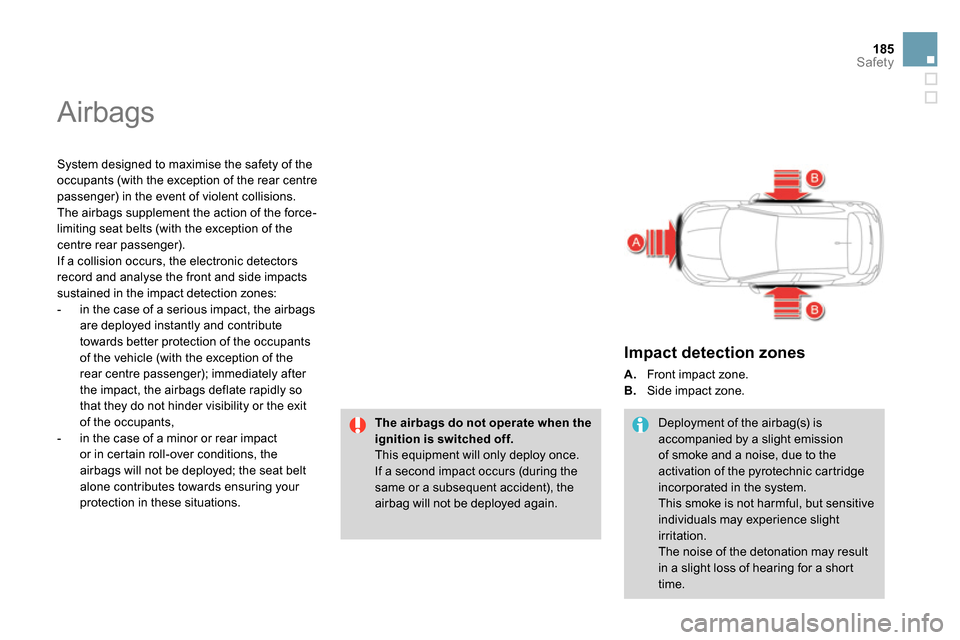
185Safety
Airbags
System designed to maximise the safety of the
occupants (with the exception of the rear centre
passenger) in the event of violent collisions.
The airbags supplement the action of the force-
limiting seat belts (with the exception of the
centre rear passenger).
If a collision occurs, the electronic detectors
record and analyse the front and side impacts
sustained in the impact detection zones:
- in the case of a serious impact, the airbags
are deployed instantly and contribute
towards better protection of the occupants
of the vehicle (with the exception of the
rear centre passenger); immediately after
the impact, the airbags deflate rapidly so
that they do not hinder visibility or the exit
of the occupants,
- in the case of a minor or rear impact
or in certain roll-over conditions, the
airbags will not be deployed; the seat belt
alone contributes towards ensuring your
protection in these situations.
The airbags do not operate when the
ignition is switched off.
This equipment will only deploy once.
If a second impact occurs (during the
same or a subsequent accident), the
airbag will not be deployed again.
Impact detection zones
A.
Front impact zone.
B.
Side impact zone.
Deployment of the airbag(s) is
accompanied by a slight emission
of smoke and a noise, due to the
activation of the pyrotechnic cartridge
incorporated in the system.
This smoke is not harmful, but sensitive
individuals may experience slight
irritation.
The noise of the detonation may result
in a slight loss of hearing for a short
time.
Page 190 of 400
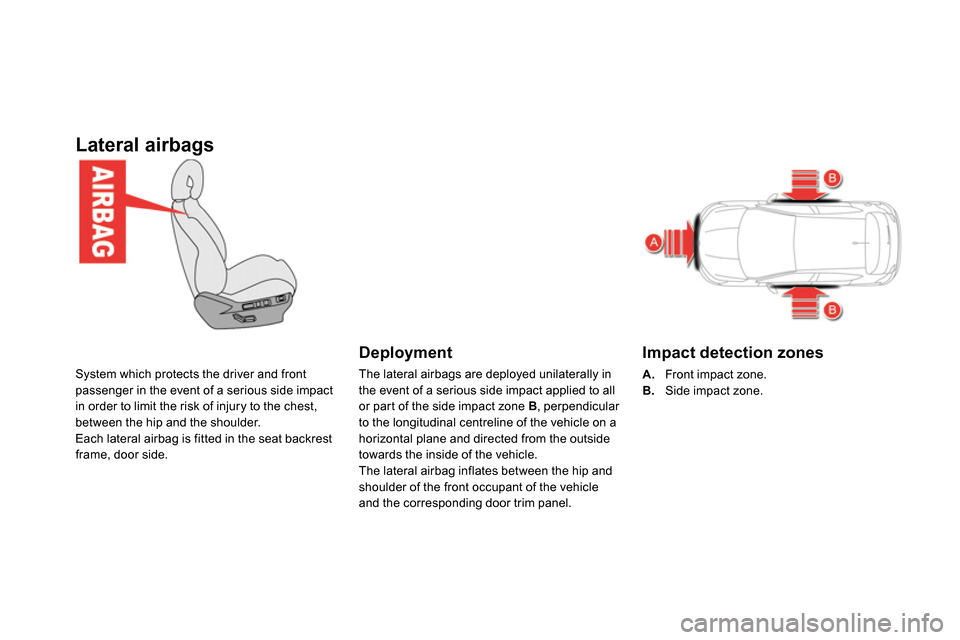
Lateral airbags
System which protects the driver and front
passenger in the event of a serious side impact
in order to limit the risk of injury to the chest,
between the hip and the shoulder.
Each lateral airbag is fitted in the seat backrest
frame, door side.
Deployment
Impact detection zones
A.
Front impact zone.
B.
Side impact zone.
The lateral airbags are deployed unilaterally in
the event of a serious side impact applied to all
or part of the side impact zone B
, perpendicular
to the longitudinal centreline of the vehicle on a
horizontal plane and directed from the outside
towards the inside of the vehicle.
The lateral airbag inflates between the hip and
shoulder of the front occupant of the vehicle
and the corresponding door trim panel.
Page 191 of 400
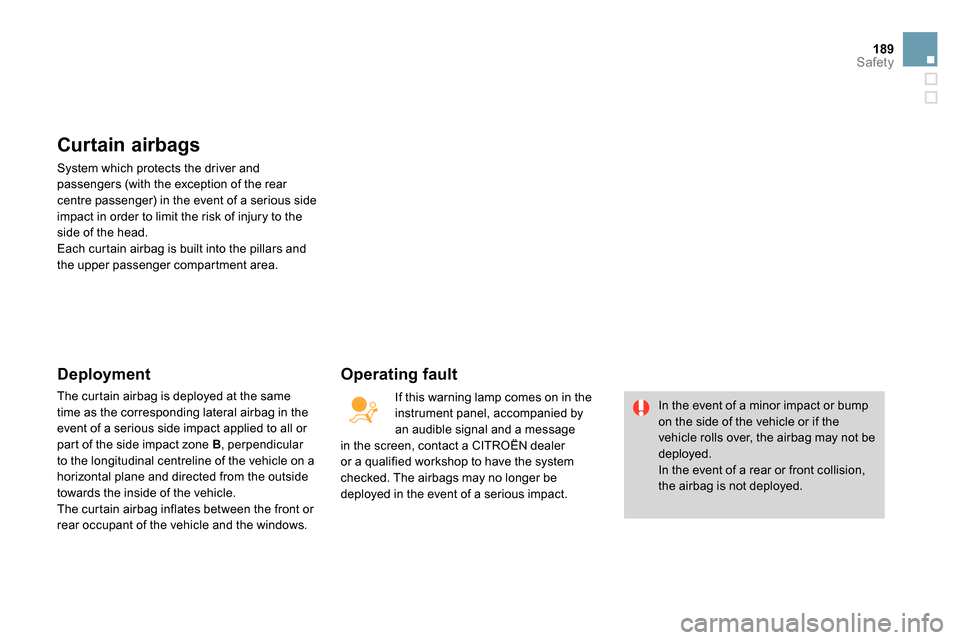
189Safety
Curtain airbags
System which protects the driver and
passengers (with the exception of the rear
centre passenger) in the event of a serious side
impact in order to limit the risk of injury to the
side of the head.
Each curtain airbag is built into the pillars and
the upper passenger compartment area.
Deployment
The curtain airbag is deployed at the same
time as the corresponding lateral airbag in the
event of a serious side impact applied to all or
part of the side impact zone B
, perpendicular
to the longitudinal centreline of the vehicle on a
horizontal plane and directed from the outside
towards the inside of the vehicle.
The curtain airbag inflates between the front or
rear occupant of the vehicle and the windows.
Operating fault
In the event of a minor impact or bump
on the side of the vehicle or if the
vehicle rolls over, the airbag may not be
deployed.
In the event of a rear or front collision,
the airbag is not deployed.
If this warning lamp comes on in the
instrument panel, accompanied by
an audible signal and a message
in the screen, contact a CITROËN dealer
or a qualified workshop to have the system
checked. The airbags may no longer be
deployed in the event of a serious impact.
Page 196 of 400
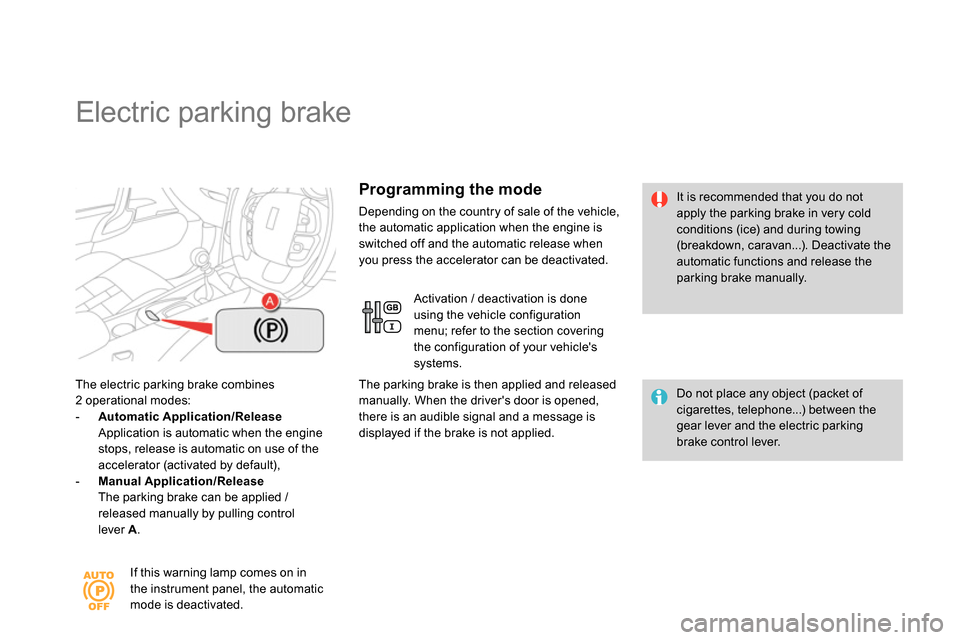
Electric parking brake
The electric parking brake combines
2 operational modes:
- Automatic Application/Release
Application is automatic when the engine
stops, release is automatic on use of the
accelerator (activated by default),
- Manual Application/Release
The parking brake can be applied /
released manually by pulling control
lever A
.
Do not place any object (packet of
cigarettes, telephone...) between the
gear lever and the electric parking
brake control lever.
It is recommended that you do not
apply the parking brake in very cold
conditions (ice) and during towing
(breakdown, caravan...). Deactivate the
automatic functions and release the
parking brake manually.
If this warning lamp comes on in
the instrument panel, the automatic
mode is deactivated.
Programming the mode
Depending on the country of sale of the vehicle,
the automatic application when the engine is
switched off and the automatic release when
you press the accelerator can be deactivated.
Activation / deactivation is done
using the vehicle configuration
menu; refer to the section covering
the configuration of your vehicle's
systems.
The parking brake is then applied and released
manually. When the driver's door is opened,
there is an audible signal and a message is
displayed if the brake is not applied.